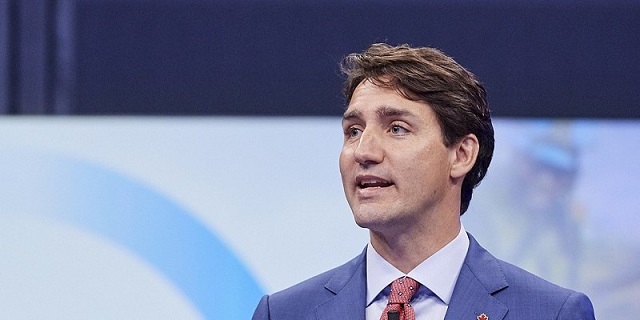Business
Federal budget fails to ‘break the glass’ on Canada’s economic growth crisis

From the Fraser Institute
By Grady Munro and Jake Fuss
“You’ve seen those signs that say, ‘In emergency, break glass.’ Well, it’s time to break the glass,” said Carolyn Rogers, Bank of Canada senior deputy governor, in a speech last month while warning that Canadians may see living standards fall if nothing is done to promote economic growth.
In advance of the Trudeau government’s 2024 budget released on Tuesday, many called for the government to finally address Canada’s stagnant economic growth. But despite the growing consensus that this issue represents a national crisis, the Trudeau government simply continued with the same approach that helped get us to this point in the first place.
“You’ve seen those signs that say, ‘In emergency, break glass.’ Well, it’s time to break the glass,” said Carolyn Rogers, Bank of Canada senior deputy governor, in a speech last month while warning that Canadians may see living standards fall if nothing is done to promote economic growth.
Ten days later in a joint interview, former Quebec premier Jean Charest and former federal finance minister Bill Morneau urged the Trudeau government to focus on economic growth in the budget. Specifically, Morneau suggested Canada needs more business investment “from other sources than the government.”
These are just two examples of the growing consensus that Canada is suffering an economic and productivity growth crisis.
Economic growth generally refers to the increase in gross domestic product (GDP), which measures the total output of the economy and is driven by three factors—the labour supply, the capital stock and the efficiency in which labour and capital are used.
Canada’s GDP growth in recent years has been driven almost entirely by the labour supply, as the country has experienced historically high population growth. However, although GDP in aggregate has been growing, GDP per person (a common indicator of living standards) has been declining at an alarming rate. Since the second quarter of 2022 (when it peaked post-COVID), inflation-adjusted GDP per person has fallen from $60,178 to $58,111 in the fourth quarter of 2023—and has declined during five of those six quarters, and now sits below where it was at the end of 2014.
Labour productivity, which is the amount of output (GDP) produced per hour worked, has seen a similar decline. Statistics Canada recently reported that the fourth quarter of 2023 represented the first time productivity increased since the beginning of 2022, and that for the prior six quarters labour productivity had declined or remained stagnant.
The consequence of both declining GDP per person and lower productivity, as Carolyn Rogers warned, is a lower standard of living for Canadians. To reverse this crisis, the Trudeau government must address the cause of Canada’s weak economic growth—a severe lack of business investment.
Business investment provides the capital needed to equip workers with the technology and equipment to become more efficient and productive. Yet according to a recent study, from 2014 to 2021, inflation-adjusted business investment per worker in Canada fell from $18,363 to $14,687.
This decline in business investment is partly the result of the Trudeau government’s disinterest in encouraging entrepreneurship and private-sector business investment. Indeed, the government’s approach of high spending, more regulation and significant involvement in the economy has done little to foster widespread economic growth.
And by raising capital gains taxes on individuals and businesses, which the Trudeau government did in this latest budget, in the words of former Bank of Canada governor David Dodge, the government is doing “exactly the wrong thing” to boost productivity. Rather, these measures simply provide more reason for people and businesses to invest elsewhere.
This latest Trudeau budget doubles down on a failed approach. Spending is up, government involvement in the economy is increasing, and increased capital gains taxes will only make our investment challenges more difficult. We need a complete reversal in policy to solve our economic growth crisis.
Authors:
Local Business
Red Deer Downtown Business Association to Wind Down Operations

The Downtown Business Association (DBA) Board of Directors has made the decision to wind down the Association’s operations at the end of 2025.
The Board determined that the Association is no longer able to operate sustainably under the financial framework available for 2026. After exploring all reasonable alternatives, the Board concluded that it could not continue without reducing services to a level that would no longer provide meaningful value to levy-paying businesses.
The DBA does not receive any operating funding from City Hall in a regular year, all funds raised are through Business Improvement Area Levy that consists of a mandatory levy placed on all businesses operating within the Business Improvement Area. These funds are legislated under the Municipal
Government Act, to be used to promote the Business Improvement Area, which is achieved through marketing and event initiatives along with providing advocacy support primarily to local government on behalf of the business community.
In recent years, the DBA has been a committed advocate for re-examining the approach to Downtown Governance. The Board has consistently maintained that the responsibility for funding downtown initiatives in such a socially charged environment should not rest solely with the business community.
Despite their efforts, the DBA recognized that the funds generated through the Business Improvement Area Levy were insufficient to effectively address the growing challenges of the current operating environment. This ongoing financial strain highlighted the need for a more equitable and sustainable
model to re-establish the downtown as a safe and welcoming heart of the city.
At the annual DBA budget presentation to City Hall, the DBA requested the essential funding needed to implement the Greater Downtown Governance Committee’s recommendations — work that the DBA is uniquely positioned to lead and has been delivering despite depleting resources for many years. The request was not approved. Instead, The City offered a one-time $100,000 Grant-in-Lieu, paired with a proposed 60% increase to the Business Improvement Area levy in 2026.
After careful analysis, the Board concluded that increasing the levy would place undue strain on already challenged businesses and compromise the DBA’s role as a trusted advocate. Operating with the reduced funding of $225,000 would require further staff reductions in an already under resourced environment and a significant reduction in programs, making it impossible to deliver the level of support that downtown businesses deserve and vitally need.
Beginning January 1, 2026, the City of Red Deer will become the primary contact point for matters previously supported by the DBA, including downtown support programs, business-district coordination, events, safety and cleanliness support, and stakeholder engagement. The DBA will work with City staff to support a smooth transition.
The DBA will continue to provide Clean Team services through the delivery of the City-funded environmental contract until February 1st, 2026.
Quote from CEO, Amanda Gould:
“To our business community, we have always operated with your best interests in our heart, continually driving the vision of a thriving downtown environment that serves every member of our community. The changes ahead will have a significant impact on downtown, as there will no longer be an organization dedicated to ensuring the downtown remains top-of-mind, leading events, marketing initiatives, or advocating on your behalf. It is likely you will experience less coordinated support and collective representation.
After 13 years of service to you and our beautiful downtown, it is with great personal sadness that we find ourselves here, but our message remains clear – addressing the unique challenges of our downtown should not rest solely on your shoulders. We cannot, in good faith, collect a levy that does not enable us to provide the essential services needed for our evolving downtown landscape”.
Quote from DBA Board Chair, Brandon Bouchard:
“The incredible staff at the Downtown Business Association have consistently delivered on their mandate with outstanding dedication and effectiveness. Through their efforts, they have successfully promoted the downtown area, organized impactful marketing and event initiatives, and provided steadfast
advocacy support for the business community. Their work has extended well beyond the legislated requirements, as they have proactively responded to the evolving needs of downtown businesses, adapting to challenges and supporting operations within a complex and changing environment.
Despite the staff’s relentless commitment to positioning the DBA as an effective leader for downtown interests, the absence of a sustainable funding model has made it impossible to continue delivering meaningful support. The Board cannot, in good conscience, propose a levy that does not enable the
Association to meet the required level of service, address the shifting priorities of the business community, or respond to the continually evolving needs of the downtown”.
Agriculture
Growing Alberta’s fresh food future

A new program funded by the Sustainable Canadian Agricultural Partnership will accelerate expansion in Alberta greenhouses and vertical farms.
Albertans want to keep their hard-earned money in the province and support producers by choosing locally grown, high-quality produce. The new three-year, $10-milllion Growing Greenhouses program aims to stimulate industry growth and provide fresh fruit and vegetables to Albertans throughout the year.
“Everything our ministry does is about ensuring Albertans have secure access to safe, high-quality food. We are continually working to build resilience and sustainability into our food production systems, increase opportunities for producers and processors, create jobs and feed Albertans. This new program will fund technologies that increase food production and improve energy efficiency.”
“Through this investment, we’re supporting Alberta’s growers and ensuring Canadians have access to fresh, locally-grown fruits and vegetables on grocery shelves year-round. This program strengthens local communities, drives innovation, and creates new opportunities for agricultural entrepreneurs, reinforcing Canada’s food system and economy.”
The Growing Greenhouses program supports the controlled environment agriculture sector with new construction or expansion improvements to existing greenhouses and vertical farms that produce food at a commercial scale. It also aligns with Alberta’s Buy Local initiative launched this year as consumers will be able to purchase more local produce all year-round.
The program was created in alignment with the needs identified by the greenhouse sector, with a goal to reduce seasonal import reliance entering fall, which increases fruit and vegetable prices.
“This program is a game-changer for Alberta’s greenhouse sector. By investing in expansion and innovation, we can grow more fresh produce year-round, reduce reliance on imports, and strengthen food security for Albertans. Our growers are ready to meet the demand with sustainable, locally grown vegetables and fruits, and this support ensures we can do so while creating new jobs and opportunities in communities across the province. We are very grateful to the Governments of Canada and Alberta for this investment in our sector and for working collaboratively with us.”
Sustainable Canadian Agricultural Partnership (Sustainable CAP)
Sustainable CAP is a five-year, $3.5-billion investment by federal, provincial and territorial governments to strengthen competitiveness, innovation and resiliency in Canada’s agriculture, agri-food and agri-based products sector. This includes $1 billion in federal programs and activities and $2.5 billion that is cost-shared 60 per cent federally and 40 per cent provincially/territorially for programs that are designed and delivered by provinces and territories.
Quick facts
- Alberta’s greenhouse sector ranks fourth in Canada:
- 195 greenhouses produce $145 million in produce and 60 per cent of them operate year-round.
- Greenhouse food production is growing by 6.2 per cent annually.
- Alberta imports $349 million in fresh produce annually.
- The program supports sector growth by investing in renewable and efficient energy systems, advanced lighting systems, energy-saving construction, and automation and robotics systems.
Related information
-

 Business1 day ago
Business1 day agoCanada Can Finally Profit From LNG If Ottawa Stops Dragging Its Feet
-

 Health2 days ago
Health2 days agoThe Data That Doesn’t Exist
-

 Business2 days ago
Business2 days agoThe Climate-Risk Industrial Complex and the Manufactured Insurance Crisis
-

 National2 days ago
National2 days agoLiberal bill “targets Christians” by removing religious exemption in hate-speech law
-

 Crime2 days ago
Crime2 days agoInside the Fortified Sinaloa-Linked Compound Canada Still Can’t Seize After 12 Years of Legal War
-

 Automotive11 hours ago
Automotive11 hours agoThe $50 Billion Question: EVs Never Delivered What Ottawa Promised
-

 Energy1 day ago
Energy1 day agoLNG NOW! Canada must act fast to prosper in changing times
-

 Health1 day ago
Health1 day agoUS podcaster Glenn Beck extends a lifeline to a Saskatchewan woman waiting for MAiD








